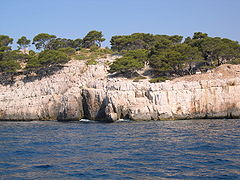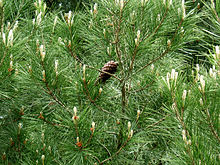This is an old revision of this page, as edited by 78.165.159.90 (talk) at 20:12, 5 May 2010. The present address (URL) is a permanent link to this revision, which may differ significantly from the current revision.
Revision as of 20:12, 5 May 2010 by 78.165.159.90 (talk)(diff) ← Previous revision | Latest revision (diff) | Newer revision → (diff)
| Aleppo Pine | |
|---|---|

| |
| Aleppo Pines at Calanques near Marseille, France | |
| Conservation status | |
 Least Concern (IUCN 2.3) | |
| Scientific classification | |
| Kingdom: | Plantae |
| Division: | Pinophyta |
| Class: | Pinopsida |
| Order: | Pinales |
| Family: | Pinaceae |
| Genus: | Pinus |
| Subgenus: | Pinus |
| Species: | P. halepensis |
| Binomial name | |
| Pinus halepensis Miller | |

| |
| Native range of Pinus halepensis | |
Pinus halepensis, commonly known as the Aleppo Pine, is a pine native to the Mediterranean region. The range extends from Morocco and Spain north to southern France, Italy and Croatia, and east to Greece and northern Libya, with an outlying population (from which it was first described) in Syria (including Aleppo), southern Turkey, Jordan and Israel. It is generally found at low altitudes, mostly from sea level to 200 m, but can grow at an altitude of up to 1000 m in southern Spain, and up to 1700 m in the south, in Morocco and Algeria.

It is a small to medium-size tree, reaching 15-25 m tall and with a trunk diameter of up to 60 cm, exceptionally up to 1 m. The bark is orange-red, thick and deeply fissured at the base of the trunk, and thin and flaky in the upper crown. The leaves ("needles") are very slender, 6-12 cm long, distinctly yellowish green and produced in pairs (rarely a few in threes). The cones are narrow conic, 5-12 cm long and 2-3 cm broad at the base when closed, green at first, ripening glossy red-brown when 24 months old. They open slowly over the next few years, a process quickened if they are exposed to heat such as in forest fires. The cones open 5-8 cm wide to allow the seeds to disperse. The seeds are 5-6 mm long, with a 20 mm wing, and are wind-dispersed.

Aleppo Pine is closely related to the Turkish Pine, Canary Island Pine and Maritime Pine which all share many of its characteristics. Some authors include the Turkish Pine as a subspecies of the Aleppo Pine, as Pinus halepensis subsp. brutia (Ten.) Holmboe, but it is usually regarded as a distinct species. It is a relatively non-variable species, with its morphological characteristics staying constant over the entire range.

It is widely planted for timber in its native area, being one of the most important trees in forestry in Algeria and Morocco. It is also a popular ornamental tree, extensively planted in parks and gardens in hot dry areas such as southern California, where its considerable heat and drought tolerance is highly valued. However, the tree is also considered a feral weed on South Australia's Eyre Peninsula, where an eradication program is in place.
The resin of the Aleppo Pine is used to flavor the Greek wine retsina.
In art
Paul Cézanne had an Aleppo Pine in his garden at Aix-en-Provence; this tree was the inspiration and model for his painting, The Big Trees. As of 2005, the tree is still growing in Cézanne's garden.
References
- ^ Farjon, A. (2005). Pines. Drawings and Descriptions of the genus Pinus. Brill, Leiden. ISBN 90-04-13916-8.
- ^ Rushforth, K. (1999). Trees of Britain and Europe. Collins ISBN 0-00-220013-9.
- ^ Nahal, I. (1962). Le Pin d'Alep (Pinus halepensis Miller). Étude taxonomique, phytogéographique, écologique et sylvicole. Ann. Éc. Nat. Eaux Forêts (Nancy) 19: 1–207.
- Christensen, K. I. (1997). Gymnospermae. Pp. 1–17 in Strid, A., & Tan, K., eds., Flora Hellenica 1. Königstein.
- Richardson, D. M., ed. (1998). Ecology and Biogeography of Pinus. Cambridge University Press ISBN 0-521-55176-5.
- Cézanne, P. Visions. In Architectural Digest December 2005: 117.